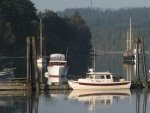Dave's clarification as to that your boat has a 110 volt system, and has a Charles 20 amp charger built in is very valuable.
Boating is a bit different than running a car. I find that the more the boater knows about his boat, and the technology involved, the better experience they will have boating.
The Charles Charger is excellent, and although the Blue Seas, has a few features which are appealing--the Charles is more than adequate for your boat!
As to AGM batteries, and specifically with Yamaha Outboards. AGM are more sensitive to over voltages than flooded lead acid batteries are, but not deadly sensitive as Gel cell batteries are. Andy from SIMS has installed hundreds of AGMs on Yahama motor installations, and states he has never seen a problem. Some of the confusion came from about 10 years ago, when Yamaha specifically stated that gel cells should not be used on their motors. It was eventually clarified, that they actually meant gel cells, but not AGM's. (But many equated gel cells and AGM's). I have owned Yamaha motors, and monitored their output voltages--about the same as all of the others, not as well regulated as alternators on cars, or battery chargers, but rare to exceed 14.4 volts. Most manufacturres of batteries state that they can be charged up to 2.4 to 2.45 volts per cell (x 6 for a 12 volt battery). (this is 14.4 to 14.7--I think 14.7 is too high). Real gel batteries should not be charged at more than 14.1 volts. All batteries are sensitive to temperature; this is perhaps more important in valve regulated batteries (AGM). This is the reason that some battery chargers have a temperature prob. The battery charger I use for rapid charging of the AGM's on my C Dory when running the freezer, also has temperature settings. I also monitor temp, voltage and current.
AGM batteries have some advantages--they can be mounted in the cabin or spaces with human habitation. They can be mounted on ends or sides (not upside down), they are "maintenance free"--so you don't have to check electrolytes every 30 days (or more often). I use AGM for my freezer, because they will accept a charge faster than a flooded lead acid battery. They have a lower self discharge rate. They may or may not last longer than flooded lead acid depending on use.
I would monitor the voltage of your batteries with a digital volt meter. With your use at this point, perhaps the Victron 700 or 702 (monitors two battery voltages) is overkill. You can get cheap 2 decimal point meters on Amazon for a low price. If your batteries are consistently being charged at out voltages over 14.6 volts, then I would either switch batteries, or turn on more "appliances"--most of the time, just the electronics, will be plenty.
Float voltage is a different story, but that is in the realm of chargers, not the motors.
No matter, you should be putting the batteries on the charger at least a day or so a week--that will give you better battery life. Also we don't know what parasitic drains your boat has on the batteries (Dave will know that, but it is possible, he was completely shutting off the batteries when not using it.)
A lot to learn--and there is a lot of information on the internet on just this subject of battery charging….

